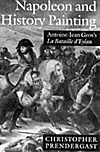
Author: Christopher Prendergast
Pages: 223
Illustrations: 48 black and white and 7 color plates of many period
paintings
Maps: None
Footnotes: 508
Appendices: None
Bibliography: 205 sources, most in French
Index: 529 entries
Publisher: Oxford University Press, Inc., New York
Publication Date: 1997
Binding: Paper (softbound)
ISBN: 0-19-817422-5 (paperback); 0-19-817402-0 (hardback)
Price: $45.00 (paperback); $85.00 (hardback)
Summary: This scholarly study attempts to explain the theory and
practice of history painting during the Napoleonic period.
Unfortunately, a potentially interesting subject is made
incomprehensible by esoteric academic prose.
Christopher Prendergast, the author, is Professor of Modern French Literature and Fellow of King's College in Cambridge, England. His book, Napoleon and History Painting (which may have been intended as a textbook), claims to be the first full-length art historical study of the painter Antoine-Jean Gros and his controversial work La Bataille d'Eylau. Eylau was the bloody stalemate fought in February 1807 by Napoleon's Grande Armée in the third campaign since its creation in 1805. David Chandler's Dictionary notes that Eylau was the nearest thing to a defeat Napoleon had experienced since his repulse at Acre in 1799. Gros's Eylau is not a triumphant painting of a glorious battlefield, but a dark scene of carnage and therefore appears to be the antithesis of propaganda.
The subject of Napoleonic history and use of paintings as propaganda is potentially fascinating. The period produced many excellent artists who recorded the great scenes and personalities of the French First Empire. Some of them were flatterers currying favor, others were men of integrity who captured the look and feel of the times. A few were much more than mere visual reporters — they produced art of striking beauty and power.
Napoleon used these men and others to help legitimize and glorify his reign. It was hoped that this book would shed new light on the subject, particularly with the impressive number of French sources used. Unfortunately, Prendergast's new book on the subject is hopelessly abstruse and unintelligible, even to a relatively intelligent layperson who is familiar with the period. The reader constantly encounters terms like "synecdochic" and "collocationary."
Confusing sentences abound: "But, as Louis Marin showed, for painting to take this proposition seriously, it had to conceive its images of regal power as not mere representation (belonging to the fallen realm of arbitrary and challengeable signs), but, via a juridical appropriation of the theology of the Eucharist, as embodiment, fully natural, unmediated, present rather than represented; the King's body (or rather one of his two bodies, the essential as distinct from the contingent) is the incarnation of the divine, and the King's portrait is its embodiment in the material of paint; in the terms of Felibien's account, the portrait of the king is the king."
The author seems incapable of writing a straightforward sentence. When he tries to, he invariably begins the next sentence with "Yet..." or "But...." There are also long passages in French with no translation provided.
Other academics in the field of art history may enjoy this work. Anyone else interested in a vastly better book on the art of the period should read The Art of Louis-Leopold Boilly: Modern Life in Napoleonic France by Susan L. Siegfried (see review in Napoleon #10).
Napoleonic Library
-
Book Review: Eagles Over the Alps
Book Review: Napoleon and History Painting
Book Review: Napoleon's Elite Cavalry
Book Review: Napoleon in the Holy Land
Book Review: Napoleon and Austerlitz
Book Review: Blundering to Glory
Book News: Review Policy
Book Review: Followup: Greenhill Napoleonic Wars Data Book
Book Review: Errata for Swords Around the Throne
Back to Table of Contents -- Napoleon #15
Back to Napoleon List of Issues
Back to MagWeb Master Magazine List
© Copyright 2000 by Napoleon LLC.
This article appears in MagWeb (Magazine Web) on the Internet World Wide Web.
The full text and graphics from other military history magazines and gaming magazines are available at http://www.magweb.com
Order Napoleon magazine direct